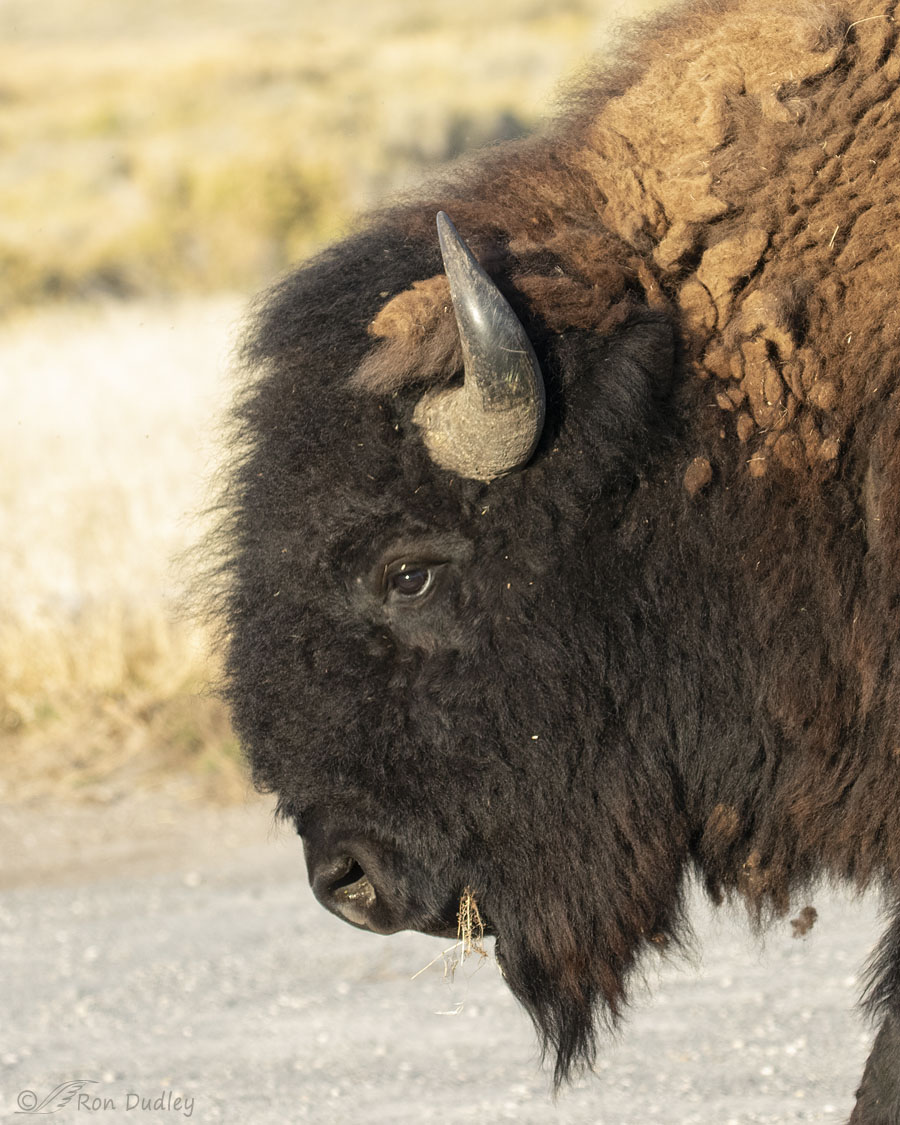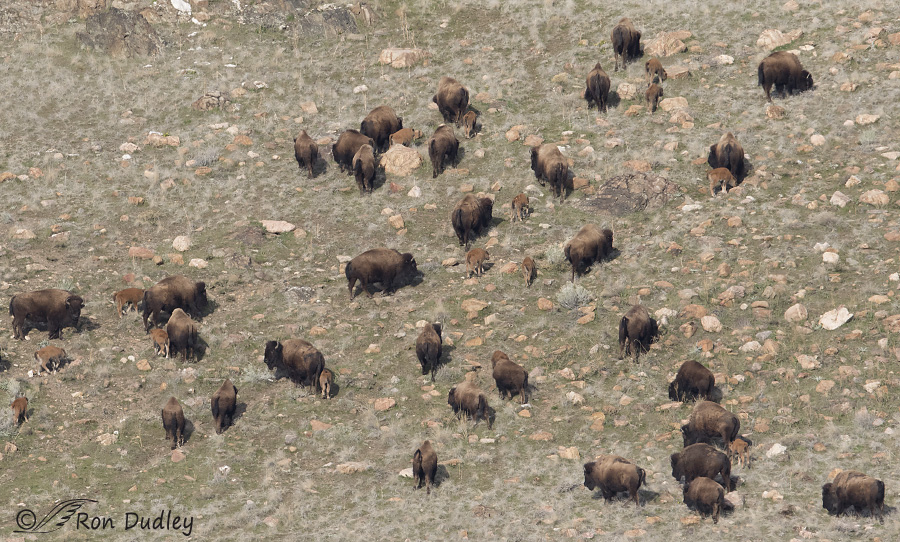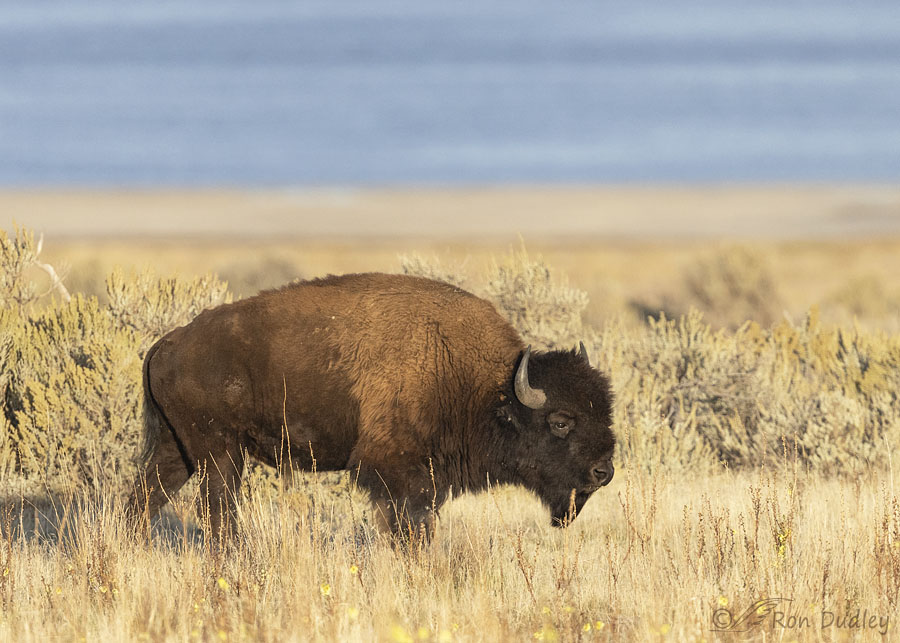I’ve been a fan, a serious student really, of the history of the American West for my entire adult life and I’m an animal lover and environmentalist to the core. So when I heard that Ken Burns had a new documentary being released on October 16th on PBS called The American Buffalo, I made a mental note to myself to watch it. I’ve watched the vast majority of Burns’ documentaries and I absolutely wasn’t going to miss this one.
But then life got in the way, October 16th came and went, and I hadn’t watched it. I just spaced it out until four days ago when…

this gnarly old bison bull walked right in front of me while I was trying (unsuccessfully) to photograph a Western Meadowlark on Antelope Island. While he was in my viewfinder my brain went ‘click’, so that night I began to watch the two part, 4 hour documetary and finished it up last night.
I thought I was well versed in the details of the natural history of the bison and the disastrous effects of its near extinction on Native Americans, but I was wrong. The American Buffalo provides a depth and breadth that I barely knew existed and Part II, which focuses on the recovery of the bison, was largely new to me.
Today there are more than 350,000 buffalo in the United States, most of them descendants of 77 animals from five founding herds at the start of the 20th century. Their recovery is a riveting story in and of itself.

Our own Antelope Island State Park, which maintains a free-roaming herd of approximately 500 buffalo, continues to play a significant role in the ongoing recovery of the American bison. This photo, taken several years ago near the south end of the island, shows a small portion of the island’s bison cows, with their calves (also called “reds”).
I’ve been a recent critic of some of the management decisions of Utah State Parks in regard to Antelope Island but, with rare exceptions, I believe they’ve done a magnificent job managing their bison. Kudos where kudos are due.
I’ve visited the island so many times for so many years and seen so many buffalo, one might think that by now they’d have become old hat for me, But that’s never happened. How could anyone ever become blasé about bison?

Later, on the same morning when I took photo #1 above, I came across this magnificent old bull with the Great Salt Lake in the upper background (I cropped the photo to feature the lake almost as much as the bison). For me the obvious allegory of the photo is to inspire a fervent hope that we can save the lake, like we saved the bison after almost destroying it.
The American Buffalo, as told by Ken Burns and a disparate collection of fascinating and sometimes flawed characters, is poignant to the point that I sometimes became emotional while watching it – especially at the end. If you watch it (I suspect some of you already have), be prepared for a similar reaction.
Very highly recommended.
Ron
Notes:
- I missed the original showing of The American Buffalo on PBS but I found it on Amazon Prime. I believe it’s available on a variety of similar platforms.
- The American bison (not a true bison) is also called the American buffalo or simply buffalo. As Burns did in his documentary, I’ve used the terms interchangeably. Usually I just call them bison.
- As is often the case with Ken Burns documentaries, Peter Coyote is the narrator for The American Buffalo. For me, Coyote’s understated style of narration, along with his Henry Fonda-ish voice and inflection, is the perfect combination for serious documentary work. Burns + Coyote = a win-win.


Thank you Ron. Definitely will give it a watch.
I have a friend who is a direct descendant of Quanah Parker and a member of the Native American Church. The eating of buffalo stew is still an integral part of their sacred peyote ceremony.
Michael, in Burns’ documentary, Quanah Parker plays a role in saving the bison.
Parker’s story, along with that of his mother, is a fascinating one. I have a book about Quanah, a biography of his life. I’ve read it twice.
Love the gnarly bison head shot. I can picture him lazily chewing away!
That’s exactly what he was doing, Catherine. He came very close to me but he didn’t pay any more attention to me than he would to a fly.
Thank you. It is ALWAYS inspiring to hear/see our rare success stories on the conservation front.
EC, too bad those “success stories” don’t happen more often.
Yes, I watched it. I had forgotten about it but as per my usual PBS time tuned into the first segment after earlier that day spending my morning siting in my car surrounded by at least 200 bison. I so enjoy my time spent with the bison, listening, watching and photographing the giants. I think I cried through a good portion of the first part. Between the slaughter of both the bison and the native Americans both of which I am very familiar of the history, I was a snotty mess. The second half was more hopeful. I found it ironic the same men who almost caused the extinction of the bison also helped often unknowingly to save the species.
Yes, I noticed that irony too, April. Charles Goodnight for example.
That first one is a helluva shot — especially for a photobomb! I’d call it wall-worthy, as is the GSL/bison shot.
There’s a herd of around 150 on Catalina Island just off the coast where I am and I’ve gone on a couple of watching tours up there. They are magnificent creatures!
I haven’t had a chance to sit and savor the Burns documentary yet, but plan to catch it on PBS streaming if I can catch it on a broadcast.
Marty, I didn’t know they had bison on Catalina. Maybe they weren’t there back in the day when I lived in SoCal.
They were brought onto the island in the 1920s for a movie shoot and then left there, if I recall correctly. Time for a road trip to SoCal — you, Mia, and April could carpool (truckpool? Jeeppool?)! 😉
What you said piqued my curiosity so I looked it up, Yup, that herd originated with the filming of The Thundering Herd, a silent film released in 1925 (smart-ass me has to wonder how they knew the herd was “thundering” if it was a silent film…)
😂😂😂
Well I am glad you did see the program by Ken Burns. I sure watched it thru the two days and it was wonderful. I knew of many of the things that was talked and shown about the life and times of the Buffalo Herds. I live in an area where I see the Buffalo pretty often. Our local park in town has a little group of maybe 6 that is kept. They keep the herd small with at least one or two reds being born each year. Thanks for the pictures you posted.
Thanks, Trudy. I’m glad you enjoyed my photos.
Thanks for the reminder about this! Yellowstone Park is actively working with several Indian Nations and various ranchers to relocate some of the Park’s buffalo. See yellowstoneforever.org
Many ranches in Montana have old wooden slide stackers standing in their fields. Slide stackers are large wooden rectangular structures that are set at an angle (like a slide) and used to make large haystacks. (see Beaverhead County Slide Stackers). As a youth in Montana, I used to tell tourists that those were ‘Buffalo jumps’. It wasn’t a good joke — it just made people confused. Locals might chuckle and then edge away from me…. Sorry, I can’t think of Buffalo jumps without thinking of slide stackers….Looking forward to the Ken Burns documentary.
Kathryn, in the documentary, Burns mentions Yellowstone’s work with the ranchers and Indians to relocate some of their bison.
Thanks for the review and the photos. I’m going to watch this for sure now!!
Good!
I Love Ken Burns and his documentaries I definitely will have to watch that. I’m met a fellow years ago at my dad’s tire shop that was out photographing a wild heard of Buffalo in Northern Wyoming. He got a little too close to Buffalo and a little too far from his truck and was charged and as he got to the vehicle the bull buffalo ran a horn through his backside taking out his kidney and breaking several ribs and pinning him to the door of his pickup. It was a really nasty scar after he recovered. Quite frankly it was a miracle that he survived after he drove himself 30 miles to the emergency room.
Wow, that’s quite a story, Steven.
Bison have attacked folks on Antelope Island before, one of them, an experienced trail runner, was killed several years ago. Usually when they attack it’s because people are acting stupid.
Love this post today Ron. We have a huge 5”x5” painting of ‘Big Bison’ in our mtn house. He is so majestic! He looks over your hawks 😄 Will definitely watch the documentary – thank you!
Kathleen, I’m thinking that your “Big Bison” might be a James Corwin painting or print?
Wow, thanks for the reminder about the documentary, Ron. We were in Montana last summer, and were fortunate to see both a “buffalo“ jump and also several of the real thing. There were also constant reminders of the dangers, including a T-shirt that made us smile: DON’T PET THE FLUFFY COWS. Thanks again! Will watch soon.
Ellen, there’s a small buffalo jump within about 10 miles of our MT farm. It’s on private land but I’ve been fortunate enough to visit it.
Now I’ll have to seek it out……. 😉 Knew there were a lot of ads for it and not being familiar with Burns I kind of went “eh” and didn’t bother….Of course, I’m familiar with the Bison/Buffalo(no, seeing them NEVER gets old) and some of the history of their near extinction by we “wonderful” “white men”. Will also have to look at Coyote. With winter here (12 this morning) I’ll have more time/interest in such things!
Judy, when it comes to documentaries, Ken Burns is in a class of his own.
27° here this morning – cold enough for me. My tomatoes still on the vine are toast… or icicles.
Judy, I heartily recommend any Ken Burns documentary! He manages to get new and fascinating information on every topic! Bring the Kleenex, though — and not in a bad way, his docs are so moving! (I cried during the baseball one.)
Thanks Ron for the reminder to watch that. I have only ever seen buffalo at the Grand Canyon north rim and in an area outside of Zion. I have read about them and their almost utter destruction. Glad you got to see some up close. I am thinking you may have seen them while growing up in Montana?
Funny about Ken Burns. Many years back I bought his Baseball series and after watching it sent a letter complaining that he completed neglected the 1950 Philadelphia Phillies Whiz Kids. If you remember it was saturated with New York. Everything was NY Yankees, Giants, and Dodgers. I got a form letter back that probably went out to thousands like me from all over the country with similar complaints. Even saying that I still very much enjoyed the series.
“I am thinking you may have seen them while growing up in Montana?”
I did, Everett. The National Bison Range is on the Flathead Indian Reservation fairly close to where I lived.
The American Buffalo production is a revelation and a sad one. I wish the white man would give credit to the native peoples in how they manage their environment. It seems to me a lot of our world would be better if they had. Ken Burns has presented great history accounts in his work.
I agree about Burns, Betty.
I haven’t yet seen the new feature-looking forward to it ! You’d be
interested to read the biography ( can’t recall the title ) of Peter
Coyote’s young life– talk about a “rehabilitated” hippie ! It’s a fun
read…….
Sounds like an interesting biography, Kris. I’ve read some hints about his checkered background but know very few of the details.
The Ken Burns documentary was a “must watch”. I was frustrated hearing again of the greed that has too often caused horrible actions against people & animals but learned lots.
Laurie, when I think of what we did to the buffalo, and to Native Americans, I become ashamed of my own species. Or at least the American variety…
I really enjoyed this series, too, and couldn’t agree more about Peter Coyote’s voice being the perfect vehicle for Burns’ work. How lucky you are to be able to see buffalo in the wild!
Cathy, yes, I’m lucky indeed.
I’m almost as big a fan of Coyote as I am of Burns.